ZONE 2 OF THE FOOD FOREST
This year started off quite busy with the Food Forest Project finally getting started. At first it went quick. Regrettably, progress slowed to a halt. That's okay. I'm happy we've gotten as far as we have and hope to continue to build on this endeavor, as has been the plan all along.
In earlier posts I discussed the plants purchased, design of zone 1, as well as planting method of the food forest we have been envisioning since 2014. The previous posts focused only on zone 1 of the food forest, which is located closest to the main entrance, as it will be most frequented.
Today's post will go over zone 2 of the food forest. It is in an area of the property close to the existing pear trees. However, it isn't somewhere we go, or plan to go, more than once or twice a week, which fits the bill for the second zone of permaculture.
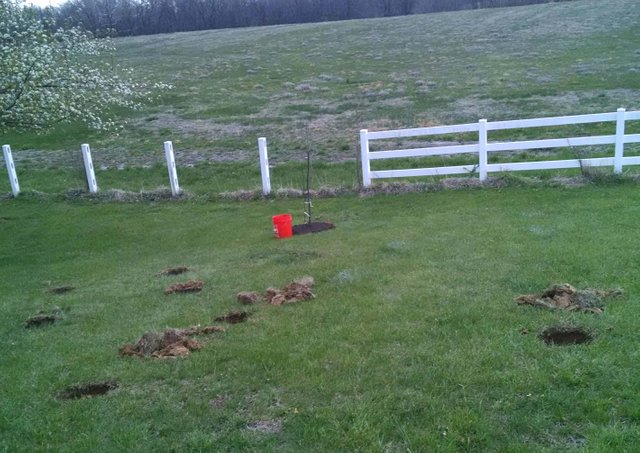
The strategy here was to find perennials that could generally spread through this area in front of the pear trees to cover this slope. Something that would spread (within reason), look beautiful, and of course be edible. It's not just that we intend to make this property a food wonderland. It's also that we want to dramatically reduce the amount of "lawncare" maintenance required. There is no way we can keep up with manicuring this as a traditional lawn in the long term. Getting as close to no-mow is ideal and has always been the plan.
Therefore, we decided to plant Jerusalem Artichokes, aka sunchokes, to start with. They are native here so should grow well in our climate, rain or drought, and have a natural tendency to spread. They can be harvested year round. They are in the sunflower family so grow tall and beautiful. At the bottom of the slope between the pear trees is a mostly shaded area already, regardless of the sunchokes. The other benefit of planting the Jerusalum artichokes above this shaded area is that it will shield this area from strong winds. We haven't figured out exactly what we want to plant there, yet.
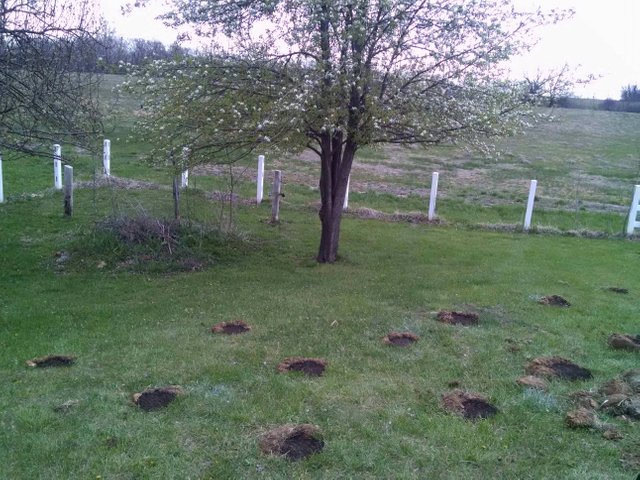
In the first post of this series I showed a picture of the 10 pound box I bought of Jerusalem Artichokes which became moldy when I was unable to plant them right away, forgetting them in the box. I washed them off hoping they would still grow, then went on my way to prepping the area as if everything would grow perfectly fine. So far so good. Glad I washed them off instead of throwing them all in the compost. 95% of what I planted is growing well.
Of the 10 lbs I purchased, at least a third of them did have to be tossed into the compost pile because they were not just moldy, but squishy and rotten. Many of the roots were smallish so I divided them up into equal portions to go into 20 holes. I could have planted each small tuber in it's own hole, but I didn't have enough holes dug and prepped to do that. Plus, the way these grow like potatoes, I knew there would be plenty of opportunities to do this in the future.
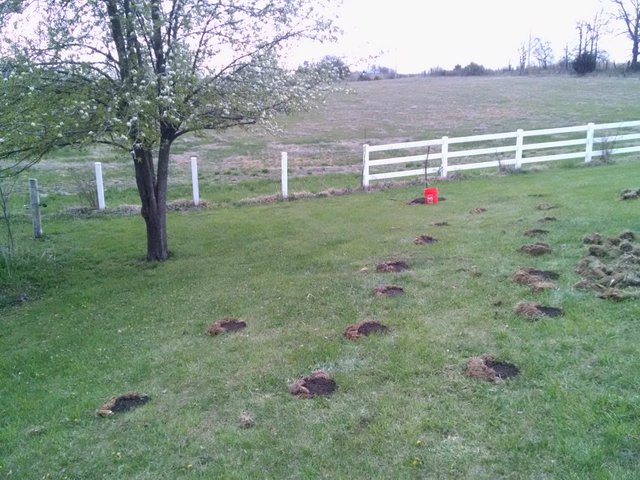
In the background here you can see the dwarf asian pear planted in front of the red pear that was in full bloom. For reference, this picture was taken May 4th and is facing East. The tree is planted in front of the red pear because it's a dwarf tree so should get plenty of sunshine all day long without shading out the red pear, that will tower behind it more than twice its size once it's full grown.
Also shown in the picture are the berms created with the mostly clay ground that was dug up when creating the holes. Even though we wanted the sunchokes to cover this section of slope, it was too labor intensive to dig up the whole area, or even dig swales. Hopefully we have bought enough time to create swales or a perimeter for this area before the sunchokes completely fill it in.
Because they are tubers it was important to plant in a way that wouldn't promote waterlogging but would also retain enough water. The berms are there to help them catch enough water to stay well hydrated, but are not so tall as to drown them when it rains heavily. This was another factor in planting them near the upper 2/3rds of the slope.
Btw, that fence is in a bad location for our goals with this property. Our land extends to the east about 40 feet beyond that fence. What we are planning to do is have a long north to south row of blackberries essentially where the fence is. The red pear is about where the lowest part of the slope is. Starting where the fence is, behind the asian pear, our plan is to plant native elderberry shrubs that we have been growing from cuttings. These will start from the east wrapping around the north to grow behind the pear trees, far enough way to still get good light most of the day from the east and west.
That means this fence has to come down. It's quite a pain in the rear because the posts are cemented in. We have neither the man power, physical ability, or equipment to dig those posts out. We have tried selling this fence but there have been no takers because no one else wants to dig out the posts, either. We decided to cut them at the base a few inches below the soil. Of course, that'll destroy them for reuse as a fence. I'm still wracking my brain to figure out a way to reuse them. They could technically still be used as a fence but the height would be cut in half. If you have good suggestions I'm all ears!!
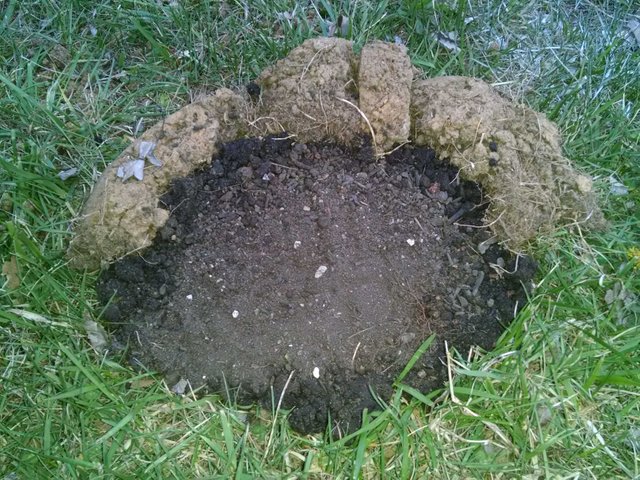
The holes were aproximately 1 foot in diameter and a foot and a half deep. Not all of the clay was used for the berm. About half of it was mixed in the bottom of the hole with the amended soil. That was made up of compost, worm castings, coconut coir, peat moss, rock dust, blood meal, and bone meal. Honestly, I forget the ratios of each. I didn't really research it. They're supposed to grow in a wide range of soil types and conditions with little fussing, so I admit I basically guessed, mimicing with how I planted the trees.
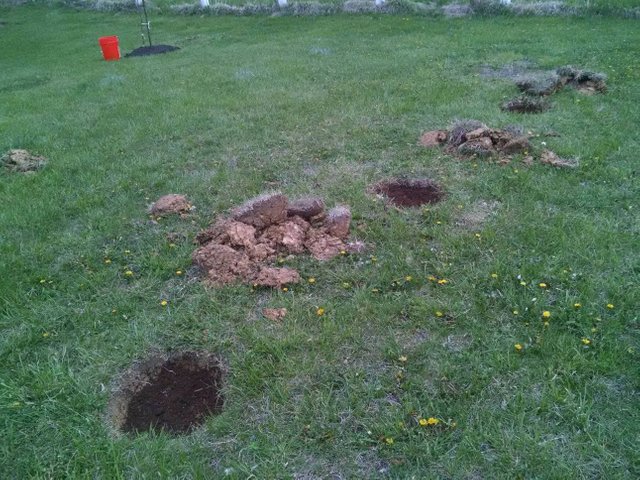
Higher up the slope I also dug holes for the blueberry patch. We have 3 types of blueberries we are trying to grow. The plan is for each of them to be in their own row. There were cuttings taken of each type in the spring but none of them rooted. It was also apparent after the first good rain that these holes did not drain well enough. If it's one thing Blueberries hate, it's having their roots become waterlogged.
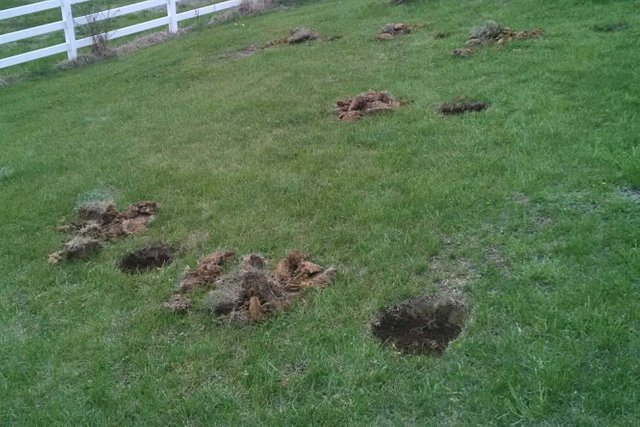
Here is another angle of the blueberry holes. What we ended up deciding to do was keep them in their pots covered thickly with straw mulch to keep them alive over the summer while we figure out how to address this waterlogging issue. These plants require more particular growing medium and conditions so this is hopefully going to be figured out in the next couple of months to get them planted and well established before they go dormant in the late fall. Also, they are small enough we were concerned about pests and animals getting to them as we don't have materials to block deer and rabbits from nibbling on them at this time.
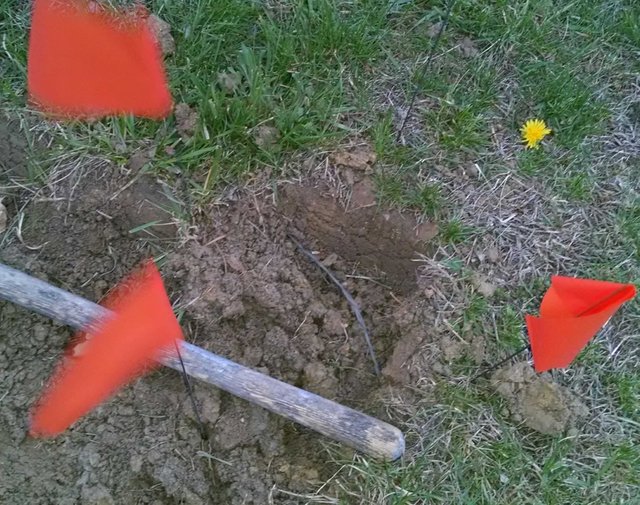
At the top of the slope between the house and the sunchokes was the 3' x 10' bed that was dug to prepare for an asparagus patch. Before any of this digging was done, we followed Missouri state law by calling utilities. CALL BEFORE YOU DIG. Anyway, this bed was started about 6 feet away from the line the telephone company marked. As you can see here, I unearthed a line. It was an ordeal figuring it out but eventually was told this was an old retired line that was not connected to anything. They said I could cut through it. Ignore it. It ended up being the last attempt to finish digging and prepping this planting area. By that time, the weather turned into extremely hot temperatures that made it impossible for me to even be outdoors. The asparagus had to find a temporary home because this planting area wasn't finished.
Back to the Jerusalem artichokes... All were planted, though mulching them wasn't completed so weeds grew tall and thick between them. Weeding them? Yeah right. Not in 100+ degree weather in no shade. It's not ideal letting the weeds have free reign but at least they are in the ground growing fairly well, despite the pest pressure from the dreaded Japanese beetles. Ugh, don't even get me started on the bugs this year. Those horribly destructive scarabs haven't been seen here until now, finally infesting our property, reeking havoc on all of this year's hard work and effort, targeting these young tender plants which have already had a difficult start in life.
I will say that although all of the plants are alive, they are not doing well. Between insect and animal pest pressure, abnormally early and prolonged high temperatures, drought, and fungal diseases, most of our food forest is really stressed out, as am I. I won't lie and say that I'm not struggling to be optimistic about it all right now. It's entirely possible these plants won't make it. As I've said before, if they survive past this coming winter, I will feel more confident.
More on this later. If you found this post enjoyable, please consider upvoting, resteeming, following, and commenting! Thank you kindly for reading...
ALL IMAGES ARE COPYRIGHT 2018 BY ME, @phedizzle. Hope you enjoyed them!
Here are previous posts of mine:
STORIES:
BAREFOOT IN THE BOONIES: EXPOSING MY ROOTS (introduction post)
BAREFOOT IN THE BOONIES: Chapter 1
BAREFOOT IN THE BOONIES: FAMILY OWNED: Chapter 1 Section 2
BAREFOOT IN THE BOONIES: ABANDONED BASEMENT: Chapter 1 Section 2
BAREFOOT IN THE BOONIES: REWIND: GROWING UP WITH TURNTABLES
2011 GARDEN:
2011: DESIGN AND BUILD
2011 BACKYARD TRELLIS, PERIMETER, & VOLUNTEER
2011 TIRE PORTION OF THE GARDEN
2011 BRASSICAS-TIRE GARDEN
2011 DWARF ORCHARD
RECIPES:
SANTA DELIVERED SHROOMS-SHITAKE OYSTER SCRAMBLE
SWEET CINNAMON POPCORN
MOCK ALMOND JOY--CHEAPER AND HEALTHIER
HANGRY TERIYAKI
RASHES--WHY I SWITCHED TO THIS COMMON DIY LAUNDRY SOAP AND HOW I MAKE IT
SCRAMBLED EGGS WITH FORAGED FINDS: FIRST FOOD FORAGE OF 2018
WHAT'S FOR DINNER? BEETS ME! FIRST GARDEN HARVEST AND RECIPE
POEMS:
WATCHING THE SPRING WAKE UP
SHE IS DYING
WEEPING WILLOW
LIGHTS OUT BABY ROBIN
PLANTS AND ANIMALS-EDUCATIONAL:
GRASS IS OUR FRIEND
LITTLE BLUESTEM--BENEFICIAL AND BEAUTIFUL
BEHOLD THE BEAUTY OF THE FALSE INDIGO BUSH
WALK ALONG WITH ME:
WALK ALONG WITH ME 1
WALK ALONG WITH ME 2--WINTER 2017/2018
2018:
WILD TURKEY TAIL AND REISHI MUSHROOMS
HUGELKULTUR BED STARTED BUT THERE IS A LOGISTICAL OBSTACLE.
2018 CURRENT HAPPENINGS: FOOD FOREST EXPANSION
WILD EDIBLES AROUND THE HOMESTEAD
GRANNY SMITH APPLE FINALLY GOT SOME LOVE
PICKED MY FIRST PINT OF WILD NATIVE BLACK RASPBERRIES
TRANSPLANTING WILD PURPLE GARLIC PART 1
ORCHARD: PLANNING, PREPPING, AND PLANTING
WILD PURPLE GARLIC TRANSPLANT UPDATE
CONTESTS/REVIEWS
Chronic and Coffee MSP Review--25 SBD contest for the best MSPWAVES Radio Reviews
VOICES FROM THE MOUNTAINS Review--25 SBD contest for the best MSPWAVES Radio Reviews

Phedizzle signature created by @bembelmaniac


(Created by @soulturtle)

Come say hello in the following Discord chat rooms:


Congratulations! This post has been upvoted from the communal account, @minnowsupport, by phedizzle from the Minnow Support Project. It's a witness project run by aggroed, ausbitbank, teamsteem, theprophet0, someguy123, neoxian, followbtcnews, and netuoso. The goal is to help Steemit grow by supporting Minnows. Please find us at the Peace, Abundance, and Liberty Network (PALnet) Discord Channel. It's a completely public and open space to all members of the Steemit community who voluntarily choose to be there.
If you would like to delegate to the Minnow Support Project you can do so by clicking on the following links: 50SP, 100SP, 250SP, 500SP, 1000SP, 5000SP.
Be sure to leave at least 50SP undelegated on your account.
Looks like a great project and one which has taken a lot of time and effort in the planning.
Look forwards to seeing the progress.
There is an easy way to remove fenceposts, if you have a pickup truck that can closely approach. Attach a chain at the base of the post, and put a wheel next to the post (a rim) that the chain drapes over before being attached to the truck, which will pull the chain.
The rim transfers the force of the pull from the truck from horizontal to vertical, pulling the fencepost straight up, which extracts it much more easily.
Hope that helps you create this amazing forest.
Thanks!
This post has been voted on from MSP3K courtesy of @isaria from the Minnow Support Project ( @minnowsupport ).
Bots Information:
Join the P.A.L. Discord | Check out MSPSteem | Listen to MSP-Waves